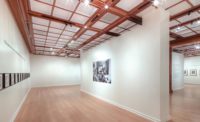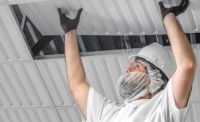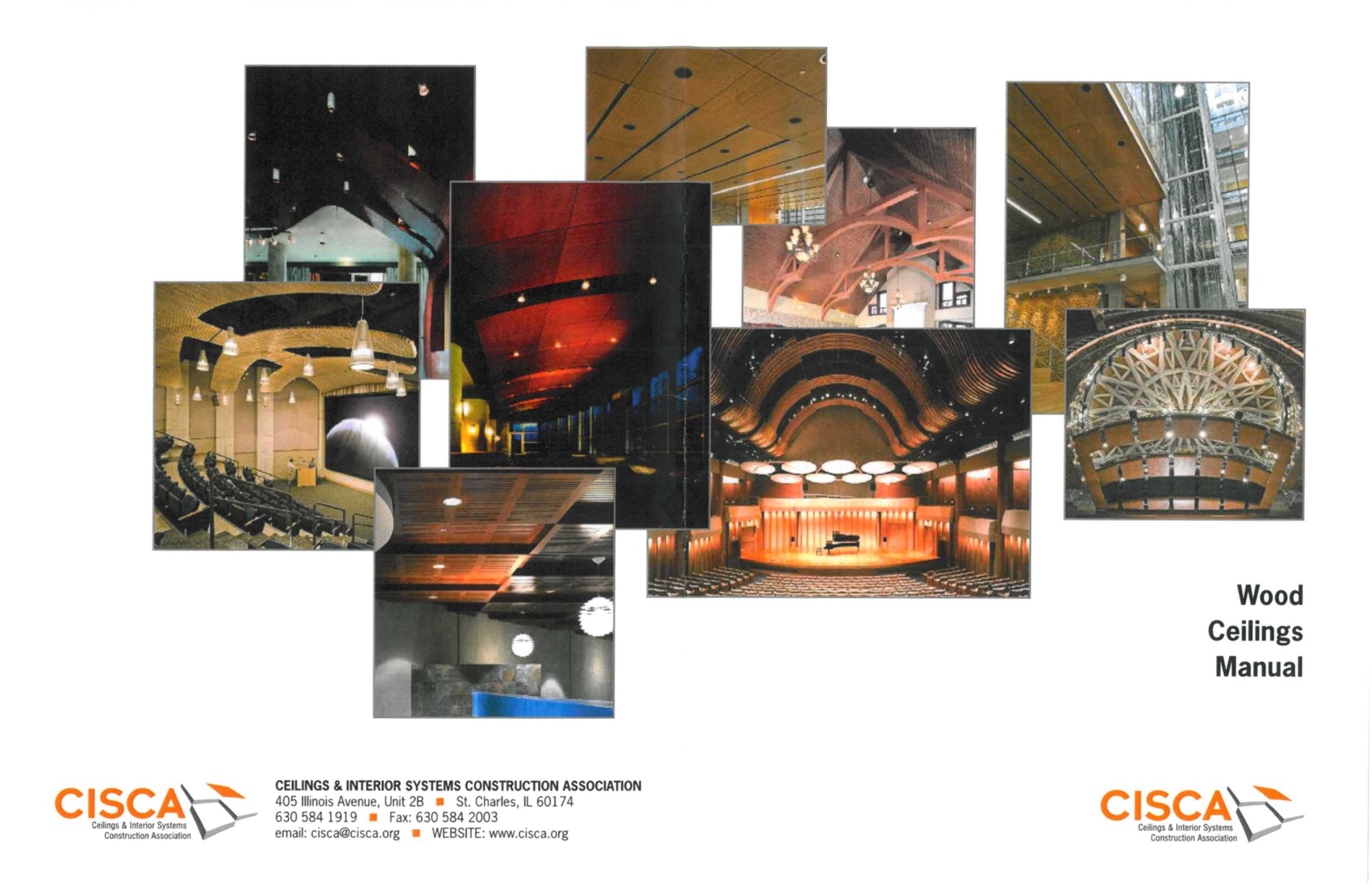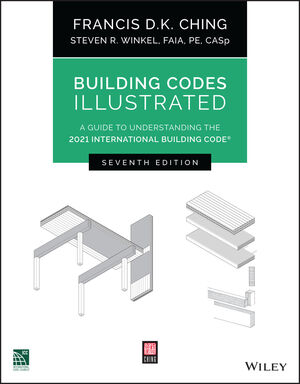The beauty of wood has long been appreciated for architectural ceiling and walls. Yet, the specialized millwork skills and tools required for high quality projects have, too often, excluded ceiling and acoustical system contractors from bidding wood projects. Fabricated from plywood or particleboard, traditional wood panels are also heavy and difficult to install or to remove for above-ceiling access.
Significant changes during the past decade, however, have led to new fabrication techniques and products complementing traditional millwork. These new materials extend the range of applications in which wood can satisfy the changing aesthetic and functional requirements of contemporary architecture.
This article examines these new developments with regard to veneers, panel cores and environmental considerations.
VENEER VARIABLES
In selecting the ideal veneer for a project, there are many considerations to take into account.
SPECIES
Wood species go in and out of demand in response to changing architectural tastes, supply and social factors such as market access and environmental concerns. Use of teak, for example, declined as old-growth stocks were depleted while plantation-grown eucalyptus has risen in popularity. North American hardwoods (e.g. oak, maple, birch, and cherry) and softwoods (e.g. pine and Douglas fir) are readily available and remain perennial favorites. Yet, designers now have unprecedented access to wood from around the world, from anigre to zebrawood.
While several dozen species account for the bulk of architectural veneer, an estimated 600 commercially harvested species present a plethora of color and figure. It is important to keep in mind, however, some species vary widely in color and figure, both within a log and from log-to-log, making it challenging to find enough sufficiently compatible veneer for a large project.
There is also growing interest in veneers that are neither hardwood nor softwood. For example, bamboo (a grass) and palm (an herbaceous monocot) have unique fibrous structures and lack annual growth rings, resulting in grains and appearances markedly different from that of true woods.
When veneer options were limited, local and regional distributors could keep the most commonly specified species in inventory. However, diversity and an international supply chain make it advisable to discuss cost and availability with panel manufacturers before using an exotic specie, especially if it is to be certified as originating in a sustainably-managed forest (as discussed later in the article).
ENGINEERED VENEERS
Complementing these options, wood can be modified to create veneers with special properties. Some processes are long-established—walnut, for example, must be cooked to obtain the most desirable coloration. Other techniques are more recent in origin.
Reconstituted wood converts fast-growing varieties to simulate the appearance of expensive or exotic hardwoods or to create looks unavailable in nature. Wood is converted into pulp, dyes introduced, the mix blended, and then pressed into “logs” that, after curing, are sliced into veneer. The carefully controlled process of compiling logs results in veneer with more consistent color and grain than natural veneer. It also has a higher use factor since less veneer has to be trimmed to remove flaws.
Other suppliers assemble layers of lumber into a log that is then sliced into veneer. Layers of darker and lighter wood are evenly distributed so the overall visual character is more harmonious, from panel to panel and from one end of a panel to the other. The same process can also be used to create a multi-colored, striped effect by interspersing several species that have a range of tones.
Techniques for creating faux wood continue to improve; some printed “veneers” now have a dimensional texture that comes close to looking like real wood, and have been reformulated to be free of polyvinyl chloride, a “chemical of concern.” They can be used to provide greater uniformity than natural veneers, or as an economical alternative to an expensive specie of wood. However, real wood, even if highly engineered, still has a luster and dimensionality that cannot be matched by a faux product; wood fibers interact with light in a way only a natural material can.
CUTTING AND SLICING
The appearance of veneer is strongly influenced by the plane, relative to the axis of the trunk, along which it was cut or sliced out of a log. Logs are first cut into slabs called “flitches”; the term also refers to the bundle of veneer into which each slab is sliced. Once trimmed to size, each piece of veneer is called a leaf.
PATTERN MATCHING
Leaves are typically bundled in the order in which they occurred in a flitch. This allows them to be matched, edge-to-edge, in sequence to create the required pattern. The orientation of leaves in relation to adjacent pieces determines the veneer pattern.
FACES
Leaves are then assembled into sheets, called “faces,” that can more readily placed over a core. Veneers must be selected and assembled to create a harmonious composition in keeping with the specified pattern and the designer’s intent. The face becomes the visible surface of a panel; while specialized machinery is used throughout the process, no robot can replace the trained eye of someone that understands and appreciates wood.
The process begins when skilled inspectors sort incoming bundles of flitches by color and figure. Selected leaves are arranged into the required pattern and fed through a machine that carefully glues the thin edges of veneer together; strips of tape may be applied to one surface to help hold the fragile leaves together. After visual inspection, faces are sent to panel manufacturers.
There, faces are adhered to a core and pressed until the bond cures. Tape, if used, must be left on the exposed surface to avoid their telegraphing through the thin veneer. Sanding removes the tape and excess glue, levels the surface and leaves the wood ready for finishing.
FINISHING
While any wood finish can be applied, factory production allows the use of ultraviolet-cured clear coatings that contain no volatile organic compound and provide a durable, low-gloss finish. If desired, wood can be stained before coating or a colorant can be put into the coating. Some wood species lighten or darken as they age, as can be seen in the rich patina of antique wood. Specifiers should allow for this when matching new construction to existing woodwork.
SOME ASSEMBLY REQUIRED
Installers should wear white gloves when handling wood panels. Panels should be installed so that the direction of wood grain is the same throughout a space unless a checkerboard or other pattern is specified.
Wood is a natural product, and variations in appearance are part of its beauty. Customers must communicate how much variation of color and figure is acceptable within an installation. It is difficult enough to find closely matching veneer for a piece of cabinetry or a small feature wall; the task becomes daunting to do so across a large ceiling or wall. Leaves within each panel must have an attractive composition, as must the array of panels throughout a space.
Ironically, randomly matched panels can be most challenging in this regard. In theory, dark heartwood and light sapwood randomly installed across a surface should be evenly distributed. However, a viewer’s attention is invariably drawn to distracting locations where a cluster of light-colored wood ends up next to a cluster of dark wood. These distractions can be minimized by specifying a “pleasing match” with veneers selected for uniformity of color without regard to grain pattern, and working with a veneer supplier and panel manufacturer willing to collaborate with the project team to understand and satisfy project requirements.
CORES FROM CANS
Almost all wood panels are made with a thin veneer, selected for aesthetics or other characteristics, adhered to a core material. Published by Architectural Woodwork Institute, Architectural Woodwork Manufacturers Association of Canada, and Woodwork Institute, the 2009 Architectural Woodwork Standards is a reliable reference for most architectural woodwork. It lists plywood, solid lumber and composite wood products, such as particleboard, as typical cores.
New core materials, however, are entering the market more rapidly than can be assimilated into consensus standards. Examples include non-wood bio-based materials, resinous and composite products, and sheet metal. In particular, aluminum sheet has been proven in use around the world and offers many features not associated with wood-based cores. This innovation is the product of advances in metallurgy, adhesives and digital fabrication techniques.
Aluminum weighs 2.8 and 4.4 kg/m2 for 1.02- and 1.63-millimeters (0.57 and 0.90 psf for 0.040 and 0.064 inches) thick sheet respectively, about a quarter the weight of 20-millimeters (3/4 inch) thick wood-based cores. Weight savings cut dead load on the ceiling suspension system and building structure. More significantly, lightweight panels are easier to handle; panels can be larger than wood-core panels, yet still lifted by just one or two people. Torsion spring clips for ceiling and lift-on brackets for walls allow non-progressive installation, and panels can be removed to commission or service equipment and utilities.
In addition to being non-combustible, aluminum cores are unaffected by moisture. This means they do not support mold and, because they do not warp or twist due to changes in humidity, they can be installed before a new building has dried out and even at exterior locations.
Veneered aluminum core can be digitally fabricated with high-speed equipment to produce curves and tessellations. Perforations, which provide both a design element and noise reduction, can be produced in an almost unlimited variety of perforation sizes, shapes and patterns.
AN EVER-GREEN MATERIAL
Intrinsic environmental qualities are part of wood’s natural appeal. People generally feel healthier and happier surrounded by natural materials—a phenomenon called “biophilia.” Forests generate oxygen, control erosion, provide habitat for wildlife and can be managed to sustain both the ecosystem and an economic system.
New methods of producing thinner veneer make increasingly efficient use of forest products—a cubic meter of wood can yield 1,400 m2 of veneer (435 square feet of veneer per 1 cf of wood), 0.7 millimeters (0.03 in.) thick or less.
Wood panels can help a project earn points within the U.S. Green Building Council’s Leadership in Energy and Environmental Design program, including the following credits:
MATERIALS AND RESOURCES CREDIT 3, MATERIALS REUSE
Wood panels with traditional cores can be difficult to remove without damage for reuse in another building. However, the light weight and accessibility of wood panels with aluminum cores make it practical to salvage and reuse panels.
MR CREDIT 4, RECYCLED CONTENT
Veneer from salvaged timbers and palms (discussed later in this article) may also contribute to recycled content. Panel cores can be 99 percent post-consumer aluminum recycled primarily from beverage containers. If it becomes necessary to remove a panel from a building, aluminum has the added advantage of being readily recyclable without loss of metallurgical value.
MR CREDIT 5, REGIONAL MATERIALS
This credit is based on use of wood harvested within 805 km (500 mi) of a project. While indigenous species contribute to regional architectural traditions—redwood in California or cypress in Louisiana, for example—designers frequently have more exotic tastes. Recent amendments to LEED allow credit calculations for rail shipments up to 2,414 kilometers (1,500 mi) and sea shipment up to 12,070 kilometers (7,500 mi). This increases the palette of wood species that can be applied toward LEED credit. Sustainably harvested hardwoods from South America, for example, are within the allowed distance to North American ports. (LEED 2009 for New Construction and Major Renovations with Alternative Compliance Paths for Projects Outside the U.S., updated in Oct. 2011)
MR CREDIT 6, RAPIDLY RENEWABLE MATERIALS
Since bamboo reaches maturity after four to six years and regenerates itself from existing roots, it qualifies for this credit. The range of bamboo veneer patterns includes edge grain, flat grain and reconstituted wood.
LEED Version 4, approved shortly before this article goes to press, expands this credit to consider bio-based materials with a range of environmental characteristics besides rapidity of growth. For example, coconut and sugar palms are typically cut down after 50 or more years when they cease to be productive. The downed trunks, some as long as 21 meters (70 feet), have limited structural use, and most are burned or left to decay in the field. According to a United Nations report, converting palm wood into higher value byproducts such as architectural veneer is sustainable and provides income for growers, most of whom operate small family farms.
MR CREDIT 7, CERTIFIED WOOD
Safeguarding against rapacious forestry practices, such as clear-cutting, has spawned several non-governmental organizations that promulgate regulations and monitor forest product commerce. These include Programme for the Endorsement of Forest Certification, Sustainable Forestry Initiative and Forest Stewardship Council.
FSC’s requirements are ensconced within LEED. MR Credit 7 states:
Use a minimum of 50 percent (based on cost) of wood-based materials and products that are certified in accordance with the Forest Stewardship Council’s principles and criteria, for wood building components.
FSC’s principles protect more than just trees; they recognize, for example, compliance with law, rights of indigenous people, and the welfare of forest workers and communities.
FSC also establishes rules for maintaining certified wood’s chain-of-custody from forest to consumer. Brokers, sawmills, distributors and manufacturers taking possession of the wood must establish procedures to prevent wood from non-certified forests against inadvertent identification as ‘certified.’ Certified wood must be identified as such on invoices and packing slips from suppliers, and must be labeled and segregated throughout each step in its journey to a jobsite. The integrity of the process is assured by independent auditors, such as Scientific Certification Systems, that certify a company’s adherence to FSC’s rules.
FSC has several categories of certified wood, including:
- FSC 100%: formerly called “FSC Pure,” this designation is for wood that comes from FSC-certified forests;
- FSC Recycled: this designation is for wood salvaged from demolished structures or other post-consumer sources; and
- FSC Mix: this indicates a certain percentage of the wood comes from FSC-certified sources, and the balance is ‘controlled’ wood (i.e. material not from certified sources, but also not produced without egregious practices such as illegal harvesting).
LEED credit calculations can take advantage of the full value of FSC 100% and FSC Recycled wood, and a percentage of the value of FSC Mix wood. Controlled wood does not contribute to LEED credits. Credit calculations are of crucial importance to projects pursuing LEED certification. A specification requiring “FSC-certified wood” can be satisfied with FSC Mix 1 percent wood, but the result may disappoint those expecting to earn LEED credit. Specifiers should be clear about their project’s requirements, specifying either “FSC 100% wood” or a minimum acceptable percentage for FSC Mix wood.
Individuals responsible for project submittals may not be familiar with chain-of-custody requirements. In Part 1–General of a wood product specification section, it is therefore also advisable to require submittal of the product manufacturer’s invoices, and packing slips indicating the FSC claims applicable to products used on the job.
Specifying certified wood can increase the cost of the material, depending on the species. The supply or quality of exotic species with FSC certification may be limited and it is prudent to discuss cost and availability with vendors before specifying. The awkwardly named “FSC Mix Credit” program alleviates some of the marketplace’s limitations. It allows veneer suppliers to meet project specifications by swapping credit from certified wood of poor aesthetic quality to better-looking wood that is not certified.
LOW-EMITTING MATERIALS—COMPOSITE WOOD AND AGRIFIBER PRODUCTS
This credit requires wood products have no added urea formaldehyde. Urea formaldehyde is widely used as a binder in manufacturing of particle cores for traditional wood panels (using aluminum cores eliminates this concern.) Formaldehyde, however, has also been used as a binder in engineered veneers, and as an adhesive to assemble veneer faces and to apply veneer to a core. Alternative binders and adhesives are increasingly available and specifiers should consult vendors for assistance in specifying NAUF products.
The Living Building Challenge, a relatively new standard for sustainable construction, has “red listed” all forms of formaldehyde, including phenol formaldehyde. Phenol formaldehyde is considered less deleterious to indoor air quality because it has a lower emission rate than that of urea formaldehyde. Still, several veneer producers no longer add this chemical to their products.
BEYOND LEED
LEED credits for low-VOC adhesives and coatings do not pertain to factory-applied adhesives or coatings. However, lifecycle considerations, including manufacturing, also contribute to a product’s environmental impact. Low-VOC adhesives are available for applying veneer to aluminum; its tenacious hold has been tested by running panels through multiple cycles in a dishwasher (an unsophisticated-but-convincing methodology), and proven in actual uses in both interior and exterior applications. UV-cured clear coatings have zero VOCs; they are durable, non-yellowing, and available with a low gloss surface.
CONTINUING TO GROW
Prior to the mid-20th century, most architectural paneling had stile and rail frames with small, inset panels of solid lumber. Veneer, when used, was thicker than that of today, and required time-consuming craftsmanship to apply.
Concurrent with advances in plywood manufacturing, veneer became thinner due to improved slicing technology and better adhesives, and manufacturing processes improved the application of veneer over core materials. The tradition of innovation continues. As photos accompanying this article show, wood panels can now be used in bigger and more diverse applications than was previously practical.
In fields where rapid change is occurring, design professionals will best be able to realize their vision through close collaboration with veneer suppliers and experienced panel manufacturers and by preparing specifications that clearly define ceiling and wall panel requirements.



















